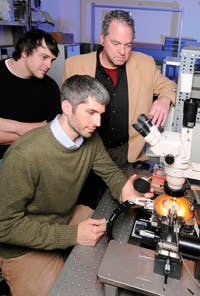Researchers at the Georgia Institute of Technology have devised a passive time-delay component which will make phase-array radars smaller, simpler, more efficient, and less expensive. The thin-film device converts electromagnetic waves into acoustic waves using a piezoelectric transducer (the changing electromagnetic signal makes the piezoelectric material change shape, creating an acoustic wave that mirrors the electromagnetic wave). The acoustic waves travel across the device, about a few microns, then hits another piezoelectric transducer that converts them back to electromagnetic waves. The time spent crossing those few microns as relatively slow-moving acoustic waves creates the delay.
So far, Georgia Tech engineers have built a delay device measuring 40 μm2 that can handle the entire radar bandwidth while delivering a 10-nsec delay.
Current phase-array radars use electrical delays which are merely sections of cable. Radar signals take about a nanosecond to travel across 1 ft of cable. The delays are critical in shaping and steering the radar beam, with each element in the array transmitting a few nanoseconds after the previous one. Without proper time delays, signals get degraded by periodic interference.
The new device can be packaged and integrated into the silicon substrate of a radar component, replacing many feet of cable, according to researchers.
Resources: Georgia Institute of Technology, www.gatech.edu

